Leadership Styles and Theories
VerifiedAdded on 2020/10/05
|11
|3337
|371
AI Summary
The report discusses the significance of leadership in achieving organizational goals and targets. It highlights the different leadership approaches, such as Transformational, Transactional, and Situational Leadership, and their implications for effective management. The report also references a company's experience with technical issues, preference share problems, and client concerns, demonstrating how these leadership styles can be applied to real-world situations.
Contribute Materials
Your contribution can guide someone’s learning journey. Share your
documents today.

Leadership/ HRM
Secure Best Marks with AI Grader
Need help grading? Try our AI Grader for instant feedback on your assignments.
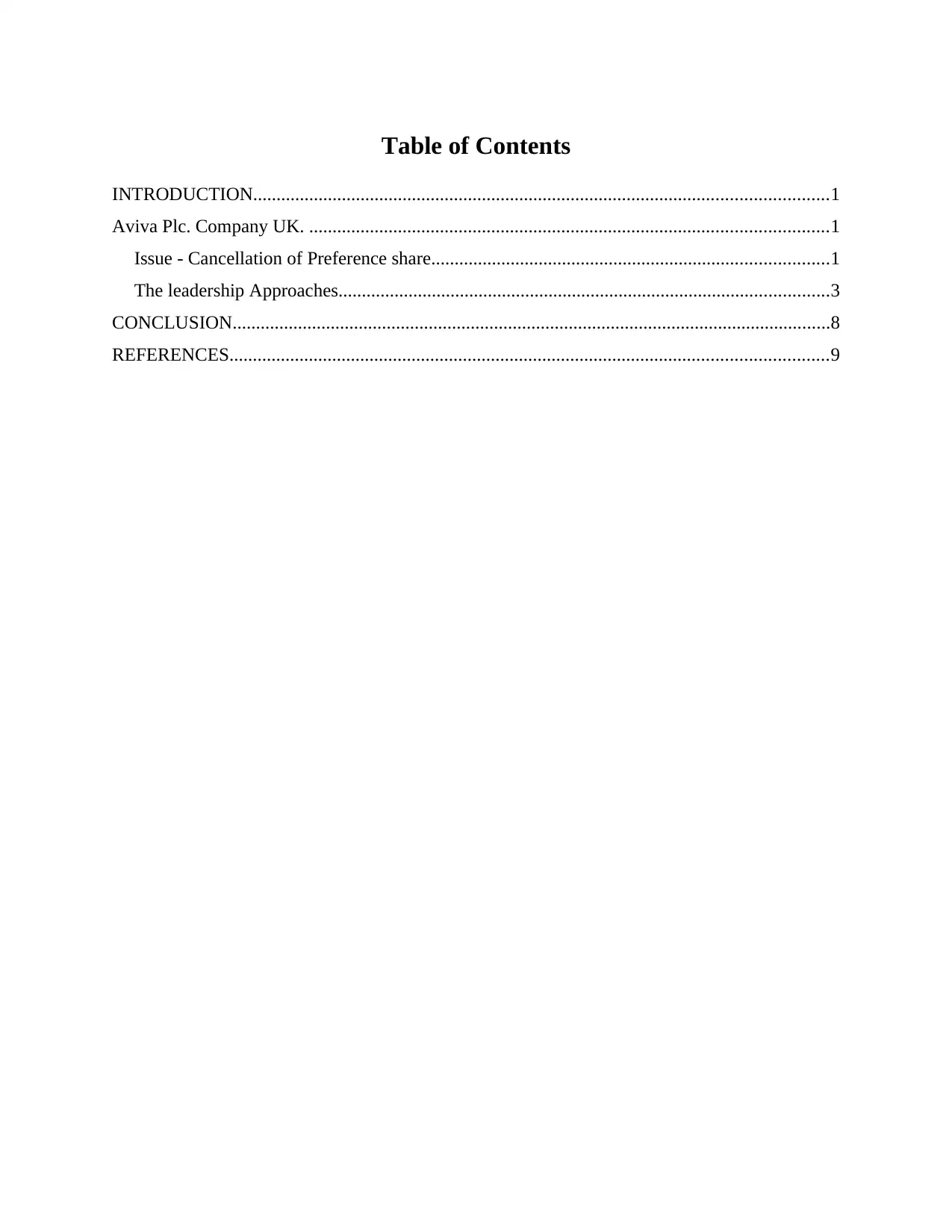
Table of Contents
INTRODUCTION...........................................................................................................................1
Aviva Plc. Company UK. ...............................................................................................................1
Issue - Cancellation of Preference share.....................................................................................1
The leadership Approaches.........................................................................................................3
CONCLUSION................................................................................................................................8
REFERENCES................................................................................................................................9
INTRODUCTION...........................................................................................................................1
Aviva Plc. Company UK. ...............................................................................................................1
Issue - Cancellation of Preference share.....................................................................................1
The leadership Approaches.........................................................................................................3
CONCLUSION................................................................................................................................8
REFERENCES................................................................................................................................9
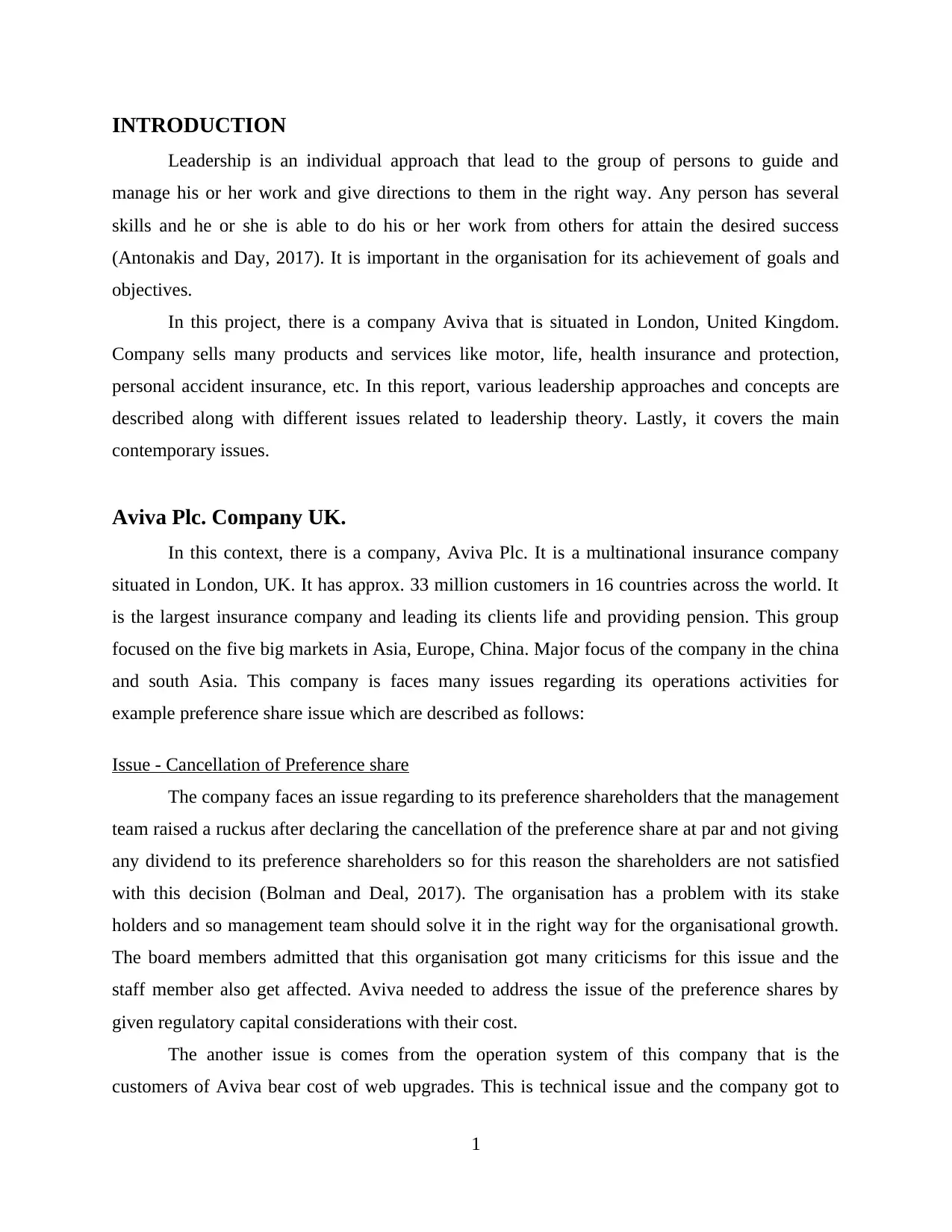
INTRODUCTION
Leadership is an individual approach that lead to the group of persons to guide and
manage his or her work and give directions to them in the right way. Any person has several
skills and he or she is able to do his or her work from others for attain the desired success
(Antonakis and Day, 2017). It is important in the organisation for its achievement of goals and
objectives.
In this project, there is a company Aviva that is situated in London, United Kingdom.
Company sells many products and services like motor, life, health insurance and protection,
personal accident insurance, etc. In this report, various leadership approaches and concepts are
described along with different issues related to leadership theory. Lastly, it covers the main
contemporary issues.
Aviva Plc. Company UK.
In this context, there is a company, Aviva Plc. It is a multinational insurance company
situated in London, UK. It has approx. 33 million customers in 16 countries across the world. It
is the largest insurance company and leading its clients life and providing pension. This group
focused on the five big markets in Asia, Europe, China. Major focus of the company in the china
and south Asia. This company is faces many issues regarding its operations activities for
example preference share issue which are described as follows:
Issue - Cancellation of Preference share
The company faces an issue regarding to its preference shareholders that the management
team raised a ruckus after declaring the cancellation of the preference share at par and not giving
any dividend to its preference shareholders so for this reason the shareholders are not satisfied
with this decision (Bolman and Deal, 2017). The organisation has a problem with its stake
holders and so management team should solve it in the right way for the organisational growth.
The board members admitted that this organisation got many criticisms for this issue and the
staff member also get affected. Aviva needed to address the issue of the preference shares by
given regulatory capital considerations with their cost.
The another issue is comes from the operation system of this company that is the
customers of Aviva bear cost of web upgrades. This is technical issue and the company got to
1
Leadership is an individual approach that lead to the group of persons to guide and
manage his or her work and give directions to them in the right way. Any person has several
skills and he or she is able to do his or her work from others for attain the desired success
(Antonakis and Day, 2017). It is important in the organisation for its achievement of goals and
objectives.
In this project, there is a company Aviva that is situated in London, United Kingdom.
Company sells many products and services like motor, life, health insurance and protection,
personal accident insurance, etc. In this report, various leadership approaches and concepts are
described along with different issues related to leadership theory. Lastly, it covers the main
contemporary issues.
Aviva Plc. Company UK.
In this context, there is a company, Aviva Plc. It is a multinational insurance company
situated in London, UK. It has approx. 33 million customers in 16 countries across the world. It
is the largest insurance company and leading its clients life and providing pension. This group
focused on the five big markets in Asia, Europe, China. Major focus of the company in the china
and south Asia. This company is faces many issues regarding its operations activities for
example preference share issue which are described as follows:
Issue - Cancellation of Preference share
The company faces an issue regarding to its preference shareholders that the management
team raised a ruckus after declaring the cancellation of the preference share at par and not giving
any dividend to its preference shareholders so for this reason the shareholders are not satisfied
with this decision (Bolman and Deal, 2017). The organisation has a problem with its stake
holders and so management team should solve it in the right way for the organisational growth.
The board members admitted that this organisation got many criticisms for this issue and the
staff member also get affected. Aviva needed to address the issue of the preference shares by
given regulatory capital considerations with their cost.
The another issue is comes from the operation system of this company that is the
customers of Aviva bear cost of web upgrades. This is technical issue and the company got to
1
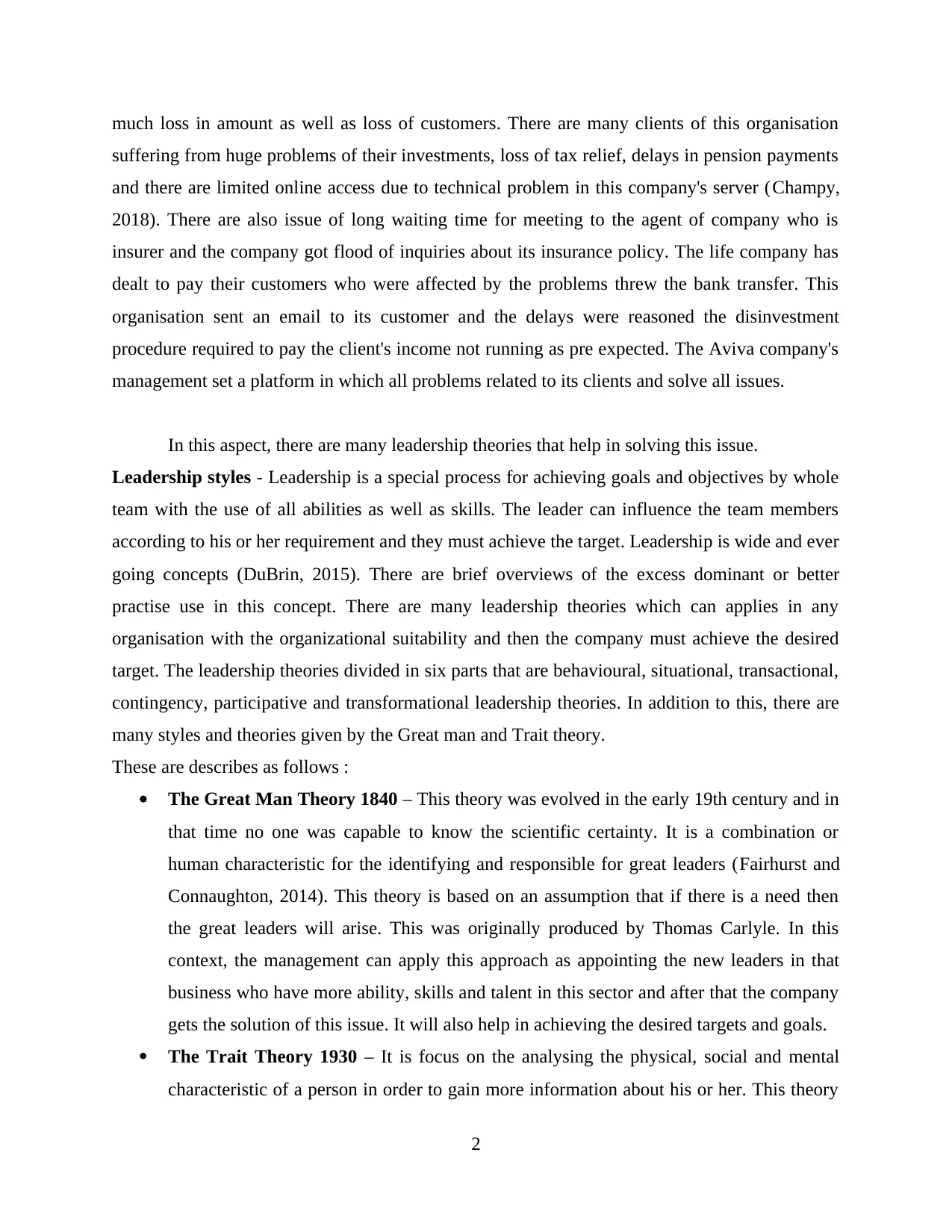
much loss in amount as well as loss of customers. There are many clients of this organisation
suffering from huge problems of their investments, loss of tax relief, delays in pension payments
and there are limited online access due to technical problem in this company's server (Champy,
2018). There are also issue of long waiting time for meeting to the agent of company who is
insurer and the company got flood of inquiries about its insurance policy. The life company has
dealt to pay their customers who were affected by the problems threw the bank transfer. This
organisation sent an email to its customer and the delays were reasoned the disinvestment
procedure required to pay the client's income not running as pre expected. The Aviva company's
management set a platform in which all problems related to its clients and solve all issues.
In this aspect, there are many leadership theories that help in solving this issue.
Leadership styles - Leadership is a special process for achieving goals and objectives by whole
team with the use of all abilities as well as skills. The leader can influence the team members
according to his or her requirement and they must achieve the target. Leadership is wide and ever
going concepts (DuBrin, 2015). There are brief overviews of the excess dominant or better
practise use in this concept. There are many leadership theories which can applies in any
organisation with the organizational suitability and then the company must achieve the desired
target. The leadership theories divided in six parts that are behavioural, situational, transactional,
contingency, participative and transformational leadership theories. In addition to this, there are
many styles and theories given by the Great man and Trait theory.
These are describes as follows :
The Great Man Theory 1840 – This theory was evolved in the early 19th century and in
that time no one was capable to know the scientific certainty. It is a combination or
human characteristic for the identifying and responsible for great leaders (Fairhurst and
Connaughton, 2014). This theory is based on an assumption that if there is a need then
the great leaders will arise. This was originally produced by Thomas Carlyle. In this
context, the management can apply this approach as appointing the new leaders in that
business who have more ability, skills and talent in this sector and after that the company
gets the solution of this issue. It will also help in achieving the desired targets and goals.
The Trait Theory 1930 – It is focus on the analysing the physical, social and mental
characteristic of a person in order to gain more information about his or her. This theory
2
suffering from huge problems of their investments, loss of tax relief, delays in pension payments
and there are limited online access due to technical problem in this company's server (Champy,
2018). There are also issue of long waiting time for meeting to the agent of company who is
insurer and the company got flood of inquiries about its insurance policy. The life company has
dealt to pay their customers who were affected by the problems threw the bank transfer. This
organisation sent an email to its customer and the delays were reasoned the disinvestment
procedure required to pay the client's income not running as pre expected. The Aviva company's
management set a platform in which all problems related to its clients and solve all issues.
In this aspect, there are many leadership theories that help in solving this issue.
Leadership styles - Leadership is a special process for achieving goals and objectives by whole
team with the use of all abilities as well as skills. The leader can influence the team members
according to his or her requirement and they must achieve the target. Leadership is wide and ever
going concepts (DuBrin, 2015). There are brief overviews of the excess dominant or better
practise use in this concept. There are many leadership theories which can applies in any
organisation with the organizational suitability and then the company must achieve the desired
target. The leadership theories divided in six parts that are behavioural, situational, transactional,
contingency, participative and transformational leadership theories. In addition to this, there are
many styles and theories given by the Great man and Trait theory.
These are describes as follows :
The Great Man Theory 1840 – This theory was evolved in the early 19th century and in
that time no one was capable to know the scientific certainty. It is a combination or
human characteristic for the identifying and responsible for great leaders (Fairhurst and
Connaughton, 2014). This theory is based on an assumption that if there is a need then
the great leaders will arise. This was originally produced by Thomas Carlyle. In this
context, the management can apply this approach as appointing the new leaders in that
business who have more ability, skills and talent in this sector and after that the company
gets the solution of this issue. It will also help in achieving the desired targets and goals.
The Trait Theory 1930 – It is focus on the analysing the physical, social and mental
characteristic of a person in order to gain more information about his or her. This theory
2
Secure Best Marks with AI Grader
Need help grading? Try our AI Grader for instant feedback on your assignments.
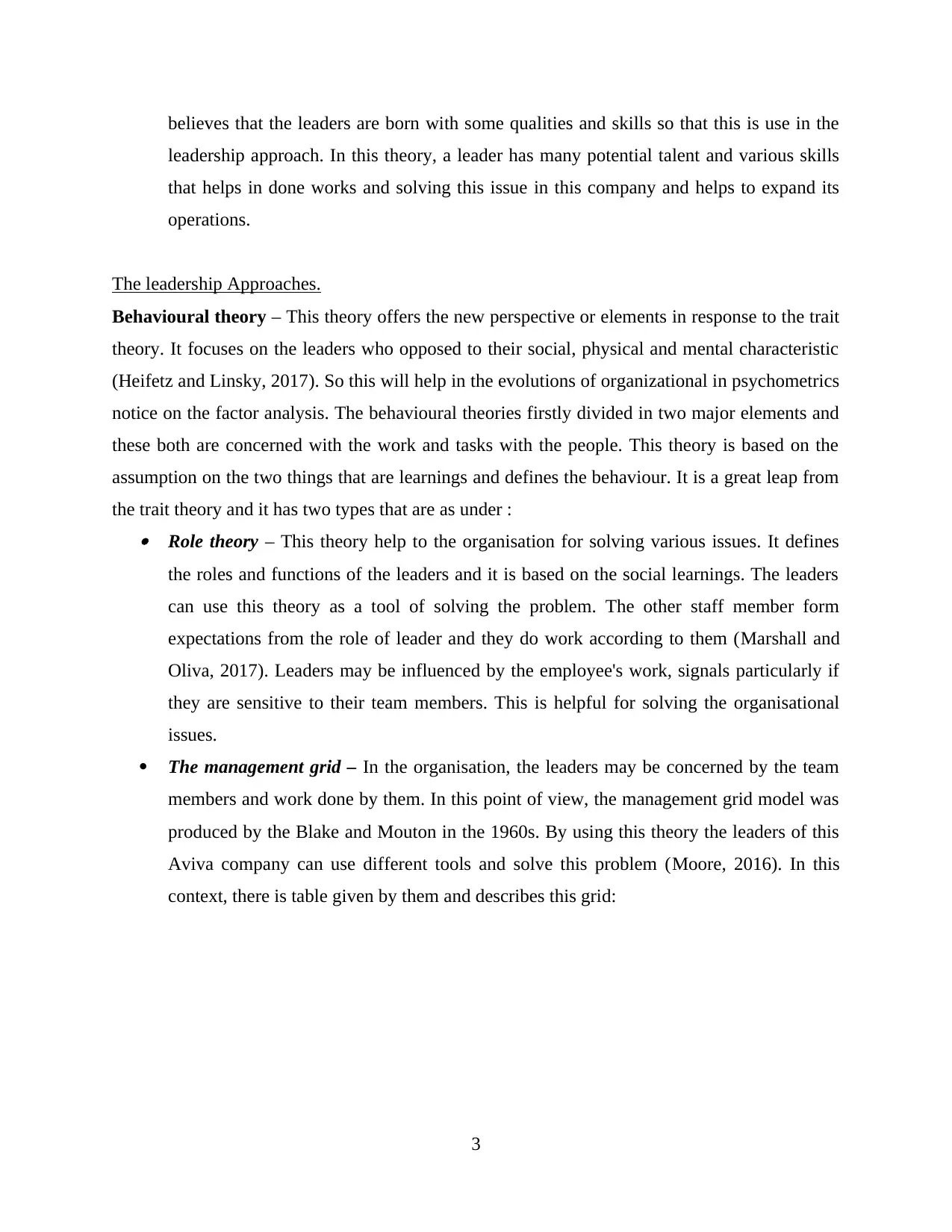
believes that the leaders are born with some qualities and skills so that this is use in the
leadership approach. In this theory, a leader has many potential talent and various skills
that helps in done works and solving this issue in this company and helps to expand its
operations.
The leadership Approaches.
Behavioural theory – This theory offers the new perspective or elements in response to the trait
theory. It focuses on the leaders who opposed to their social, physical and mental characteristic
(Heifetz and Linsky, 2017). So this will help in the evolutions of organizational in psychometrics
notice on the factor analysis. The behavioural theories firstly divided in two major elements and
these both are concerned with the work and tasks with the people. This theory is based on the
assumption on the two things that are learnings and defines the behaviour. It is a great leap from
the trait theory and it has two types that are as under : Role theory – This theory help to the organisation for solving various issues. It defines
the roles and functions of the leaders and it is based on the social learnings. The leaders
can use this theory as a tool of solving the problem. The other staff member form
expectations from the role of leader and they do work according to them (Marshall and
Oliva, 2017). Leaders may be influenced by the employee's work, signals particularly if
they are sensitive to their team members. This is helpful for solving the organisational
issues.
The management grid – In the organisation, the leaders may be concerned by the team
members and work done by them. In this point of view, the management grid model was
produced by the Blake and Mouton in the 1960s. By using this theory the leaders of this
Aviva company can use different tools and solve this problem (Moore, 2016). In this
context, there is table given by them and describes this grid:
3
leadership approach. In this theory, a leader has many potential talent and various skills
that helps in done works and solving this issue in this company and helps to expand its
operations.
The leadership Approaches.
Behavioural theory – This theory offers the new perspective or elements in response to the trait
theory. It focuses on the leaders who opposed to their social, physical and mental characteristic
(Heifetz and Linsky, 2017). So this will help in the evolutions of organizational in psychometrics
notice on the factor analysis. The behavioural theories firstly divided in two major elements and
these both are concerned with the work and tasks with the people. This theory is based on the
assumption on the two things that are learnings and defines the behaviour. It is a great leap from
the trait theory and it has two types that are as under : Role theory – This theory help to the organisation for solving various issues. It defines
the roles and functions of the leaders and it is based on the social learnings. The leaders
can use this theory as a tool of solving the problem. The other staff member form
expectations from the role of leader and they do work according to them (Marshall and
Oliva, 2017). Leaders may be influenced by the employee's work, signals particularly if
they are sensitive to their team members. This is helpful for solving the organisational
issues.
The management grid – In the organisation, the leaders may be concerned by the team
members and work done by them. In this point of view, the management grid model was
produced by the Blake and Mouton in the 1960s. By using this theory the leaders of this
Aviva company can use different tools and solve this problem (Moore, 2016). In this
context, there is table given by them and describes this grid:
3
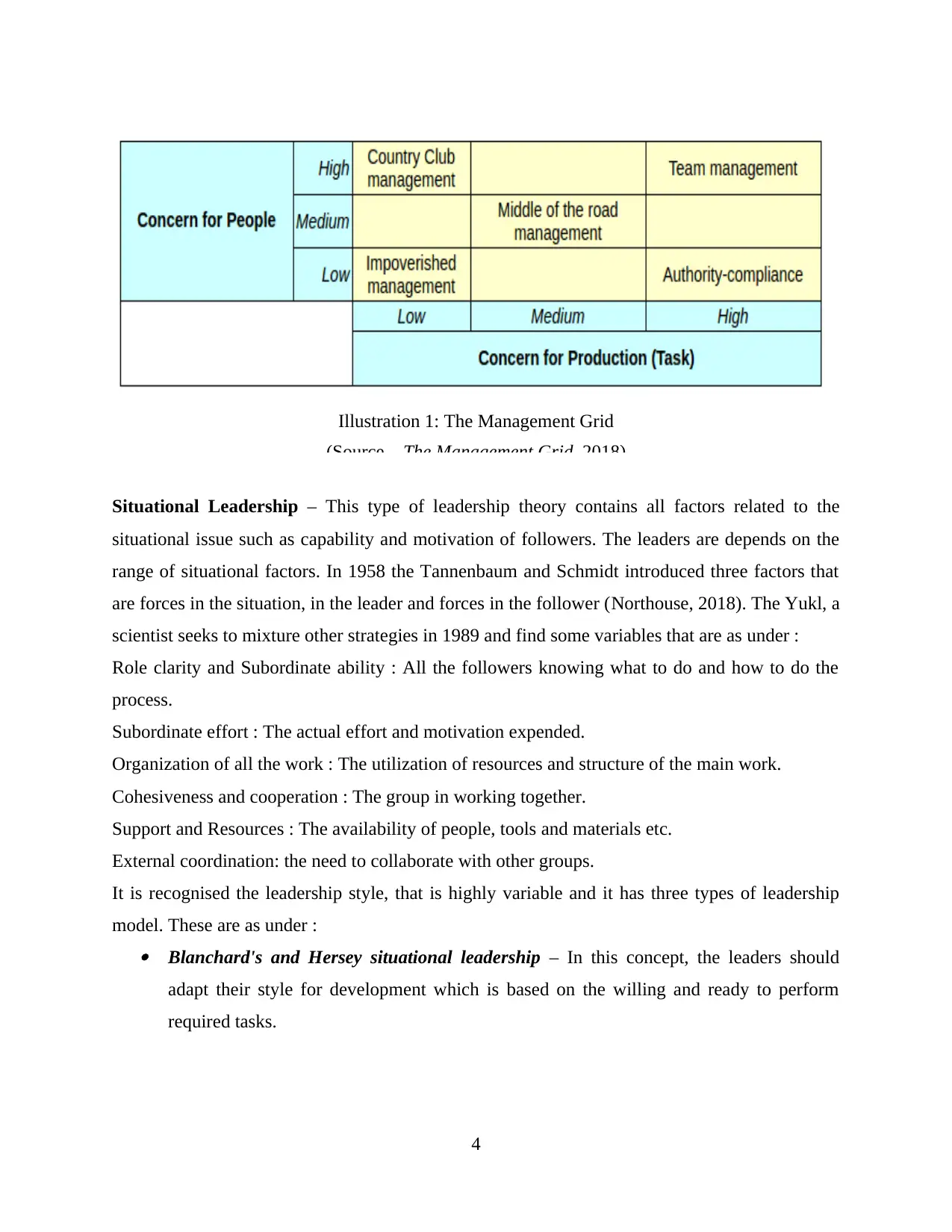
Situational Leadership – This type of leadership theory contains all factors related to the
situational issue such as capability and motivation of followers. The leaders are depends on the
range of situational factors. In 1958 the Tannenbaum and Schmidt introduced three factors that
are forces in the situation, in the leader and forces in the follower (Northouse, 2018). The Yukl, a
scientist seeks to mixture other strategies in 1989 and find some variables that are as under :
Role clarity and Subordinate ability : All the followers knowing what to do and how to do the
process.
Subordinate effort : The actual effort and motivation expended.
Organization of all the work : The utilization of resources and structure of the main work.
Cohesiveness and cooperation : The group in working together.
Support and Resources : The availability of people, tools and materials etc.
External coordination: the need to collaborate with other groups.
It is recognised the leadership style, that is highly variable and it has three types of leadership
model. These are as under : Blanchard's and Hersey situational leadership – In this concept, the leaders should
adapt their style for development which is based on the willing and ready to perform
required tasks.
4
Illustration 1: The Management Grid
(Source – The Management Grid, 2018)
situational issue such as capability and motivation of followers. The leaders are depends on the
range of situational factors. In 1958 the Tannenbaum and Schmidt introduced three factors that
are forces in the situation, in the leader and forces in the follower (Northouse, 2018). The Yukl, a
scientist seeks to mixture other strategies in 1989 and find some variables that are as under :
Role clarity and Subordinate ability : All the followers knowing what to do and how to do the
process.
Subordinate effort : The actual effort and motivation expended.
Organization of all the work : The utilization of resources and structure of the main work.
Cohesiveness and cooperation : The group in working together.
Support and Resources : The availability of people, tools and materials etc.
External coordination: the need to collaborate with other groups.
It is recognised the leadership style, that is highly variable and it has three types of leadership
model. These are as under : Blanchard's and Hersey situational leadership – In this concept, the leaders should
adapt their style for development which is based on the willing and ready to perform
required tasks.
4
Illustration 1: The Management Grid
(Source – The Management Grid, 2018)
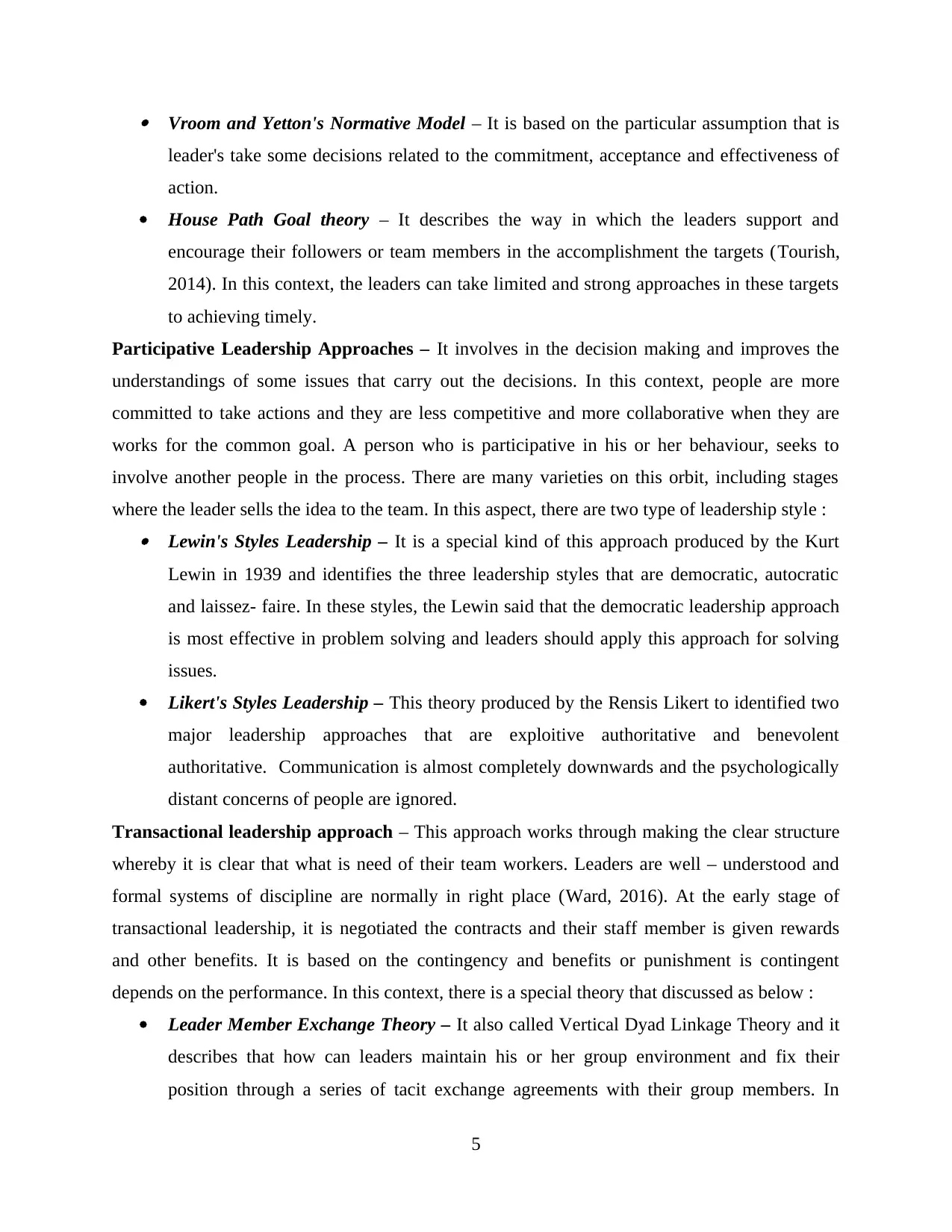
Vroom and Yetton's Normative Model – It is based on the particular assumption that is
leader's take some decisions related to the commitment, acceptance and effectiveness of
action.
House Path Goal theory – It describes the way in which the leaders support and
encourage their followers or team members in the accomplishment the targets (Tourish,
2014). In this context, the leaders can take limited and strong approaches in these targets
to achieving timely.
Participative Leadership Approaches – It involves in the decision making and improves the
understandings of some issues that carry out the decisions. In this context, people are more
committed to take actions and they are less competitive and more collaborative when they are
works for the common goal. A person who is participative in his or her behaviour, seeks to
involve another people in the process. There are many varieties on this orbit, including stages
where the leader sells the idea to the team. In this aspect, there are two type of leadership style : Lewin's Styles Leadership – It is a special kind of this approach produced by the Kurt
Lewin in 1939 and identifies the three leadership styles that are democratic, autocratic
and laissez- faire. In these styles, the Lewin said that the democratic leadership approach
is most effective in problem solving and leaders should apply this approach for solving
issues.
Likert's Styles Leadership – This theory produced by the Rensis Likert to identified two
major leadership approaches that are exploitive authoritative and benevolent
authoritative. Communication is almost completely downwards and the psychologically
distant concerns of people are ignored.
Transactional leadership approach – This approach works through making the clear structure
whereby it is clear that what is need of their team workers. Leaders are well – understood and
formal systems of discipline are normally in right place (Ward, 2016). At the early stage of
transactional leadership, it is negotiated the contracts and their staff member is given rewards
and other benefits. It is based on the contingency and benefits or punishment is contingent
depends on the performance. In this context, there is a special theory that discussed as below :
Leader Member Exchange Theory – It also called Vertical Dyad Linkage Theory and it
describes that how can leaders maintain his or her group environment and fix their
position through a series of tacit exchange agreements with their group members. In
5
leader's take some decisions related to the commitment, acceptance and effectiveness of
action.
House Path Goal theory – It describes the way in which the leaders support and
encourage their followers or team members in the accomplishment the targets (Tourish,
2014). In this context, the leaders can take limited and strong approaches in these targets
to achieving timely.
Participative Leadership Approaches – It involves in the decision making and improves the
understandings of some issues that carry out the decisions. In this context, people are more
committed to take actions and they are less competitive and more collaborative when they are
works for the common goal. A person who is participative in his or her behaviour, seeks to
involve another people in the process. There are many varieties on this orbit, including stages
where the leader sells the idea to the team. In this aspect, there are two type of leadership style : Lewin's Styles Leadership – It is a special kind of this approach produced by the Kurt
Lewin in 1939 and identifies the three leadership styles that are democratic, autocratic
and laissez- faire. In these styles, the Lewin said that the democratic leadership approach
is most effective in problem solving and leaders should apply this approach for solving
issues.
Likert's Styles Leadership – This theory produced by the Rensis Likert to identified two
major leadership approaches that are exploitive authoritative and benevolent
authoritative. Communication is almost completely downwards and the psychologically
distant concerns of people are ignored.
Transactional leadership approach – This approach works through making the clear structure
whereby it is clear that what is need of their team workers. Leaders are well – understood and
formal systems of discipline are normally in right place (Ward, 2016). At the early stage of
transactional leadership, it is negotiated the contracts and their staff member is given rewards
and other benefits. It is based on the contingency and benefits or punishment is contingent
depends on the performance. In this context, there is a special theory that discussed as below :
Leader Member Exchange Theory – It also called Vertical Dyad Linkage Theory and it
describes that how can leaders maintain his or her group environment and fix their
position through a series of tacit exchange agreements with their group members. In
5
Paraphrase This Document
Need a fresh take? Get an instant paraphrase of this document with our AI Paraphraser
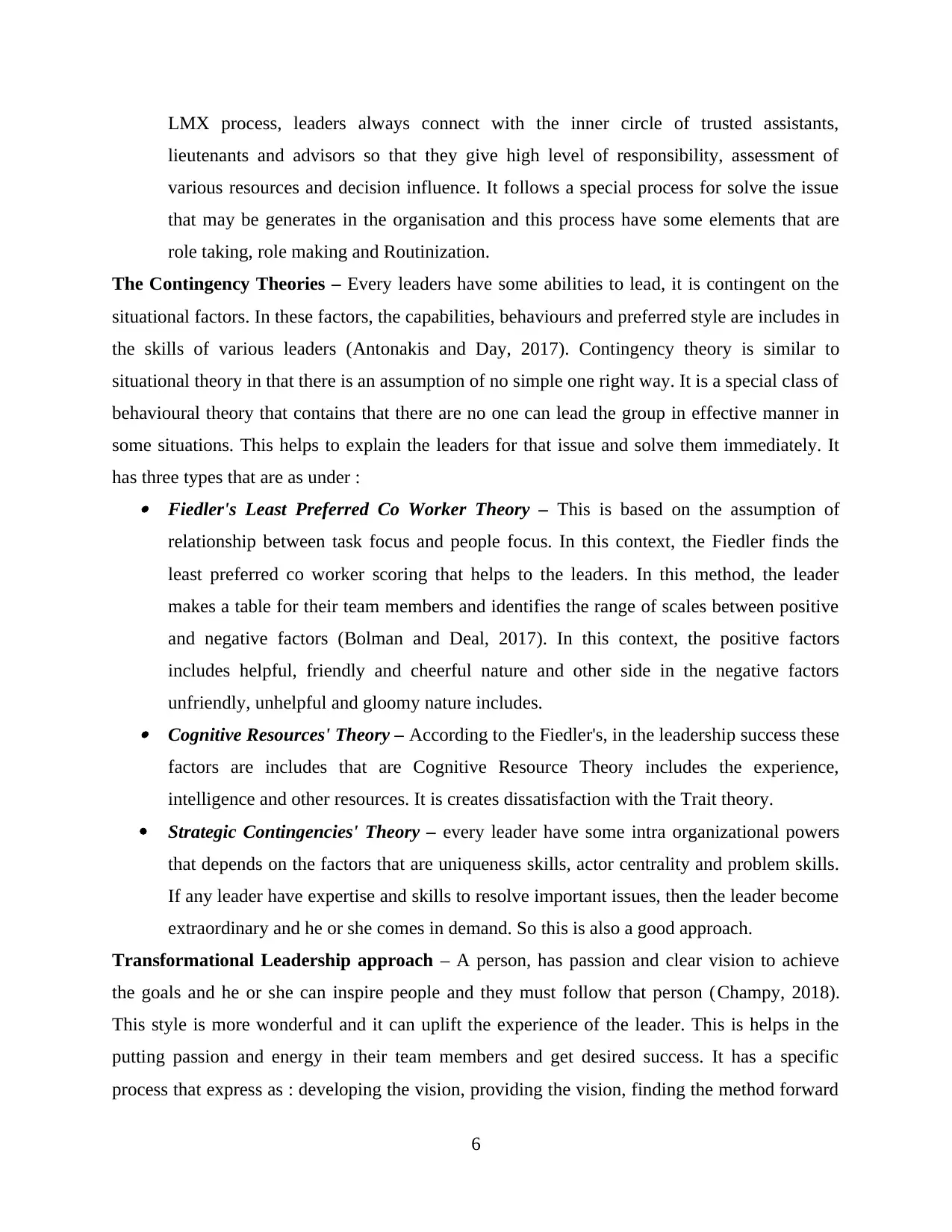
LMX process, leaders always connect with the inner circle of trusted assistants,
lieutenants and advisors so that they give high level of responsibility, assessment of
various resources and decision influence. It follows a special process for solve the issue
that may be generates in the organisation and this process have some elements that are
role taking, role making and Routinization.
The Contingency Theories – Every leaders have some abilities to lead, it is contingent on the
situational factors. In these factors, the capabilities, behaviours and preferred style are includes in
the skills of various leaders (Antonakis and Day, 2017). Contingency theory is similar to
situational theory in that there is an assumption of no simple one right way. It is a special class of
behavioural theory that contains that there are no one can lead the group in effective manner in
some situations. This helps to explain the leaders for that issue and solve them immediately. It
has three types that are as under : Fiedler's Least Preferred Co Worker Theory – This is based on the assumption of
relationship between task focus and people focus. In this context, the Fiedler finds the
least preferred co worker scoring that helps to the leaders. In this method, the leader
makes a table for their team members and identifies the range of scales between positive
and negative factors (Bolman and Deal, 2017). In this context, the positive factors
includes helpful, friendly and cheerful nature and other side in the negative factors
unfriendly, unhelpful and gloomy nature includes. Cognitive Resources' Theory – According to the Fiedler's, in the leadership success these
factors are includes that are Cognitive Resource Theory includes the experience,
intelligence and other resources. It is creates dissatisfaction with the Trait theory.
Strategic Contingencies' Theory – every leader have some intra organizational powers
that depends on the factors that are uniqueness skills, actor centrality and problem skills.
If any leader have expertise and skills to resolve important issues, then the leader become
extraordinary and he or she comes in demand. So this is also a good approach.
Transformational Leadership approach – A person, has passion and clear vision to achieve
the goals and he or she can inspire people and they must follow that person (Champy, 2018).
This style is more wonderful and it can uplift the experience of the leader. This is helps in the
putting passion and energy in their team members and get desired success. It has a specific
process that express as : developing the vision, providing the vision, finding the method forward
6
lieutenants and advisors so that they give high level of responsibility, assessment of
various resources and decision influence. It follows a special process for solve the issue
that may be generates in the organisation and this process have some elements that are
role taking, role making and Routinization.
The Contingency Theories – Every leaders have some abilities to lead, it is contingent on the
situational factors. In these factors, the capabilities, behaviours and preferred style are includes in
the skills of various leaders (Antonakis and Day, 2017). Contingency theory is similar to
situational theory in that there is an assumption of no simple one right way. It is a special class of
behavioural theory that contains that there are no one can lead the group in effective manner in
some situations. This helps to explain the leaders for that issue and solve them immediately. It
has three types that are as under : Fiedler's Least Preferred Co Worker Theory – This is based on the assumption of
relationship between task focus and people focus. In this context, the Fiedler finds the
least preferred co worker scoring that helps to the leaders. In this method, the leader
makes a table for their team members and identifies the range of scales between positive
and negative factors (Bolman and Deal, 2017). In this context, the positive factors
includes helpful, friendly and cheerful nature and other side in the negative factors
unfriendly, unhelpful and gloomy nature includes. Cognitive Resources' Theory – According to the Fiedler's, in the leadership success these
factors are includes that are Cognitive Resource Theory includes the experience,
intelligence and other resources. It is creates dissatisfaction with the Trait theory.
Strategic Contingencies' Theory – every leader have some intra organizational powers
that depends on the factors that are uniqueness skills, actor centrality and problem skills.
If any leader have expertise and skills to resolve important issues, then the leader become
extraordinary and he or she comes in demand. So this is also a good approach.
Transformational Leadership approach – A person, has passion and clear vision to achieve
the goals and he or she can inspire people and they must follow that person (Champy, 2018).
This style is more wonderful and it can uplift the experience of the leader. This is helps in the
putting passion and energy in their team members and get desired success. It has a specific
process that express as : developing the vision, providing the vision, finding the method forward
6
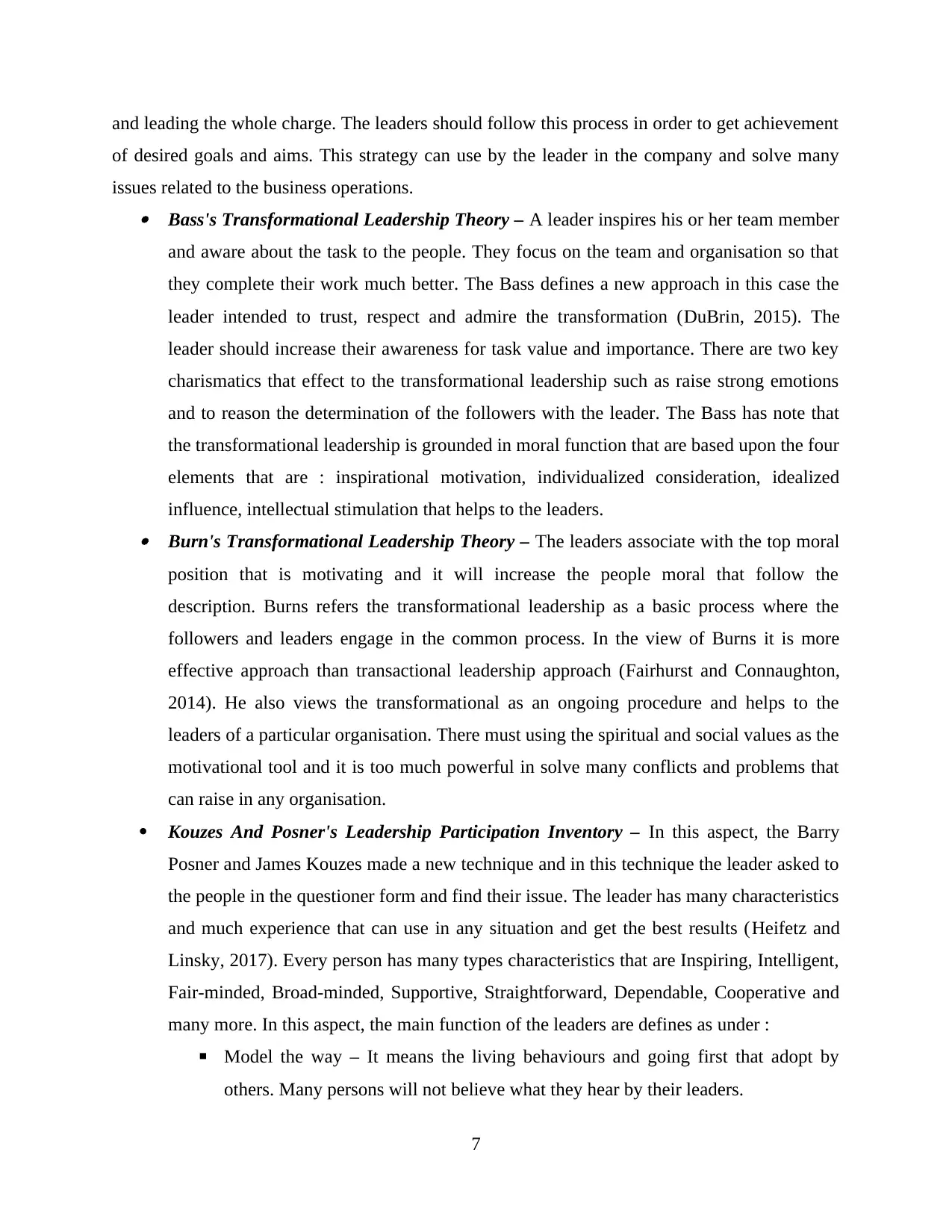
and leading the whole charge. The leaders should follow this process in order to get achievement
of desired goals and aims. This strategy can use by the leader in the company and solve many
issues related to the business operations. Bass's Transformational Leadership Theory – A leader inspires his or her team member
and aware about the task to the people. They focus on the team and organisation so that
they complete their work much better. The Bass defines a new approach in this case the
leader intended to trust, respect and admire the transformation (DuBrin, 2015). The
leader should increase their awareness for task value and importance. There are two key
charismatics that effect to the transformational leadership such as raise strong emotions
and to reason the determination of the followers with the leader. The Bass has note that
the transformational leadership is grounded in moral function that are based upon the four
elements that are : inspirational motivation, individualized consideration, idealized
influence, intellectual stimulation that helps to the leaders. Burn's Transformational Leadership Theory – The leaders associate with the top moral
position that is motivating and it will increase the people moral that follow the
description. Burns refers the transformational leadership as a basic process where the
followers and leaders engage in the common process. In the view of Burns it is more
effective approach than transactional leadership approach (Fairhurst and Connaughton,
2014). He also views the transformational as an ongoing procedure and helps to the
leaders of a particular organisation. There must using the spiritual and social values as the
motivational tool and it is too much powerful in solve many conflicts and problems that
can raise in any organisation.
Kouzes And Posner's Leadership Participation Inventory – In this aspect, the Barry
Posner and James Kouzes made a new technique and in this technique the leader asked to
the people in the questioner form and find their issue. The leader has many characteristics
and much experience that can use in any situation and get the best results (Heifetz and
Linsky, 2017). Every person has many types characteristics that are Inspiring, Intelligent,
Fair-minded, Broad-minded, Supportive, Straightforward, Dependable, Cooperative and
many more. In this aspect, the main function of the leaders are defines as under :
▪ Model the way – It means the living behaviours and going first that adopt by
others. Many persons will not believe what they hear by their leaders.
7
of desired goals and aims. This strategy can use by the leader in the company and solve many
issues related to the business operations. Bass's Transformational Leadership Theory – A leader inspires his or her team member
and aware about the task to the people. They focus on the team and organisation so that
they complete their work much better. The Bass defines a new approach in this case the
leader intended to trust, respect and admire the transformation (DuBrin, 2015). The
leader should increase their awareness for task value and importance. There are two key
charismatics that effect to the transformational leadership such as raise strong emotions
and to reason the determination of the followers with the leader. The Bass has note that
the transformational leadership is grounded in moral function that are based upon the four
elements that are : inspirational motivation, individualized consideration, idealized
influence, intellectual stimulation that helps to the leaders. Burn's Transformational Leadership Theory – The leaders associate with the top moral
position that is motivating and it will increase the people moral that follow the
description. Burns refers the transformational leadership as a basic process where the
followers and leaders engage in the common process. In the view of Burns it is more
effective approach than transactional leadership approach (Fairhurst and Connaughton,
2014). He also views the transformational as an ongoing procedure and helps to the
leaders of a particular organisation. There must using the spiritual and social values as the
motivational tool and it is too much powerful in solve many conflicts and problems that
can raise in any organisation.
Kouzes And Posner's Leadership Participation Inventory – In this aspect, the Barry
Posner and James Kouzes made a new technique and in this technique the leader asked to
the people in the questioner form and find their issue. The leader has many characteristics
and much experience that can use in any situation and get the best results (Heifetz and
Linsky, 2017). Every person has many types characteristics that are Inspiring, Intelligent,
Fair-minded, Broad-minded, Supportive, Straightforward, Dependable, Cooperative and
many more. In this aspect, the main function of the leaders are defines as under :
▪ Model the way – It means the living behaviours and going first that adopt by
others. Many persons will not believe what they hear by their leaders.
7
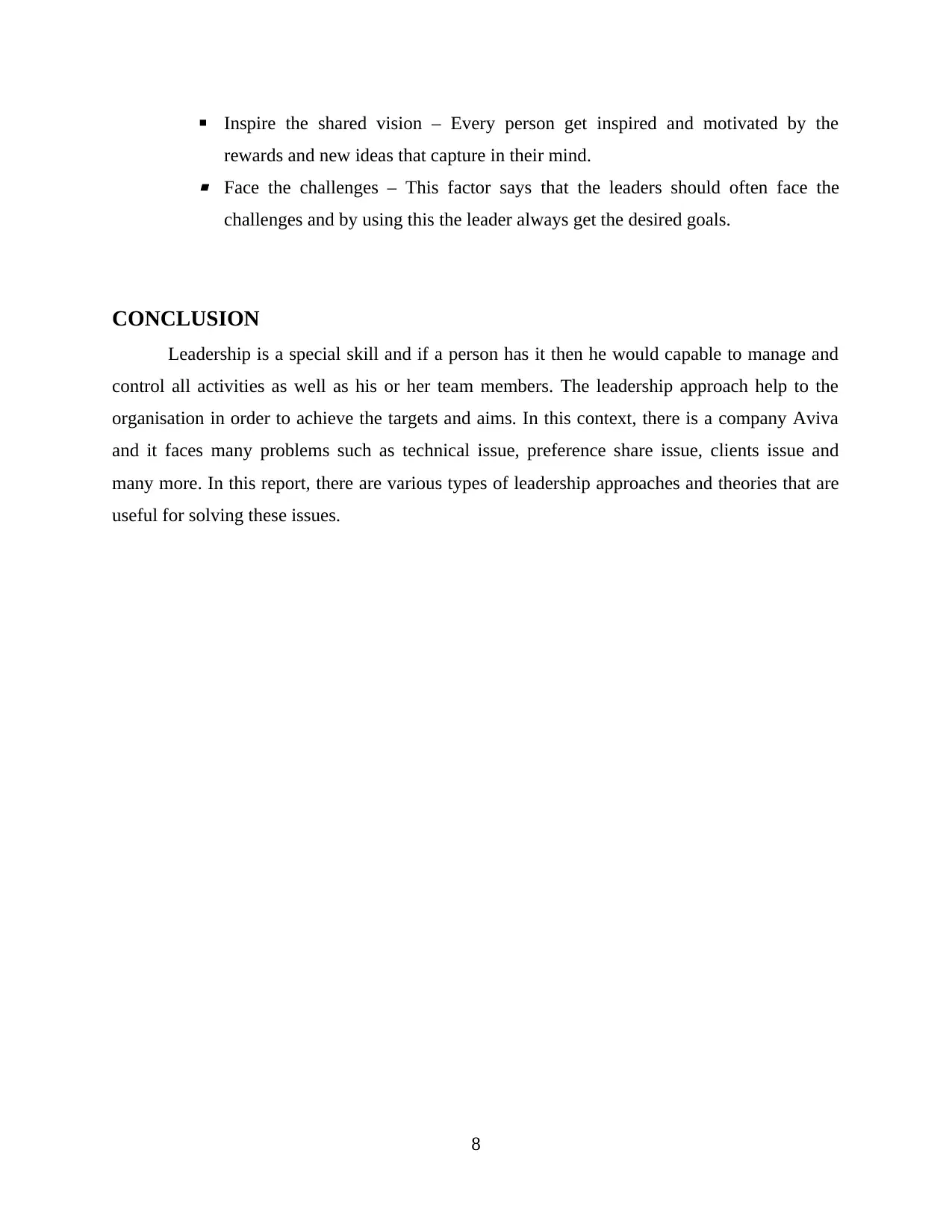
▪ Inspire the shared vision – Every person get inspired and motivated by the
rewards and new ideas that capture in their mind.
▪ Face the challenges – This factor says that the leaders should often face the
challenges and by using this the leader always get the desired goals.
CONCLUSION
Leadership is a special skill and if a person has it then he would capable to manage and
control all activities as well as his or her team members. The leadership approach help to the
organisation in order to achieve the targets and aims. In this context, there is a company Aviva
and it faces many problems such as technical issue, preference share issue, clients issue and
many more. In this report, there are various types of leadership approaches and theories that are
useful for solving these issues.
8
rewards and new ideas that capture in their mind.
▪ Face the challenges – This factor says that the leaders should often face the
challenges and by using this the leader always get the desired goals.
CONCLUSION
Leadership is a special skill and if a person has it then he would capable to manage and
control all activities as well as his or her team members. The leadership approach help to the
organisation in order to achieve the targets and aims. In this context, there is a company Aviva
and it faces many problems such as technical issue, preference share issue, clients issue and
many more. In this report, there are various types of leadership approaches and theories that are
useful for solving these issues.
8
Secure Best Marks with AI Grader
Need help grading? Try our AI Grader for instant feedback on your assignments.
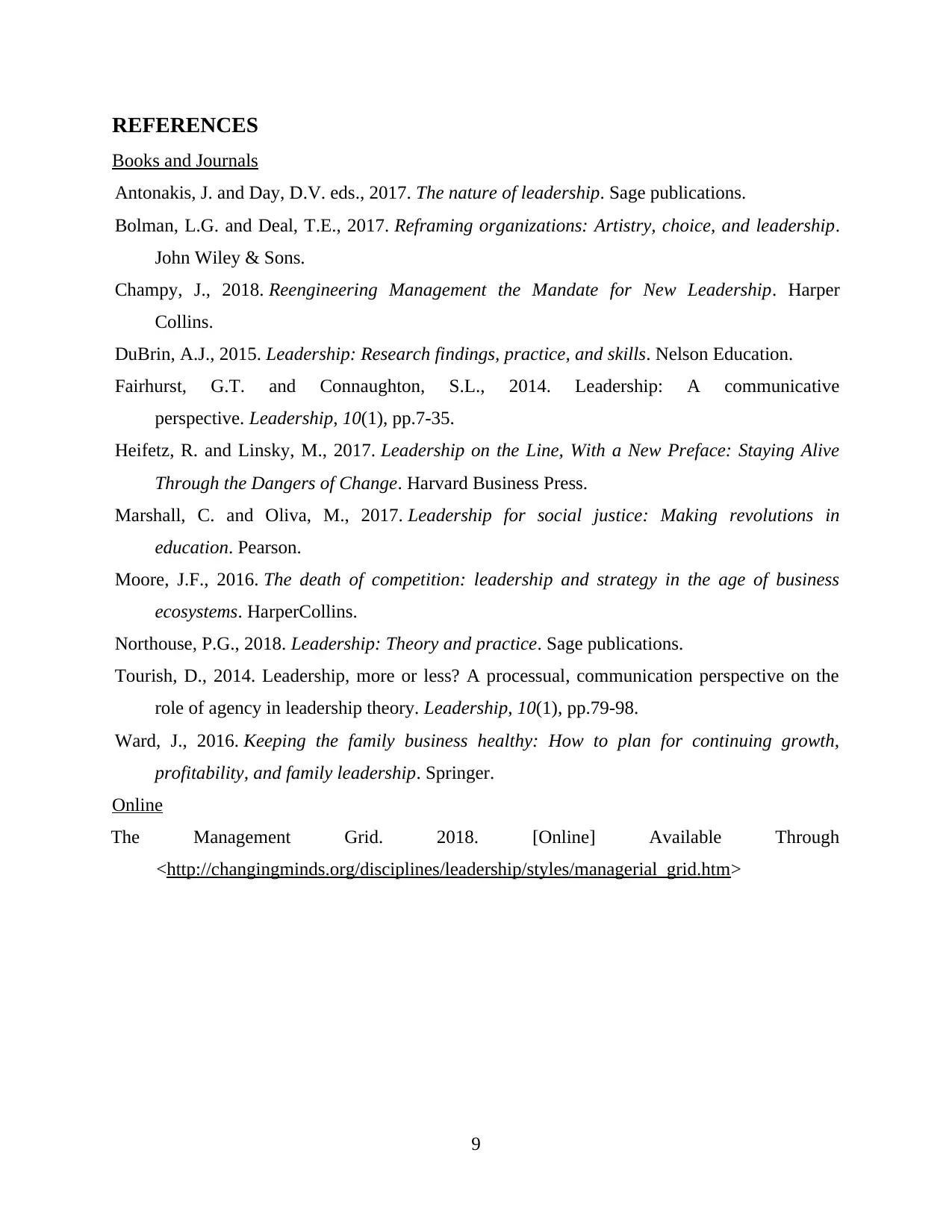
REFERENCES
Books and Journals
Antonakis, J. and Day, D.V. eds., 2017. The nature of leadership. Sage publications.
Bolman, L.G. and Deal, T.E., 2017. Reframing organizations: Artistry, choice, and leadership.
John Wiley & Sons.
Champy, J., 2018. Reengineering Management the Mandate for New Leadership. Harper
Collins.
DuBrin, A.J., 2015. Leadership: Research findings, practice, and skills. Nelson Education.
Fairhurst, G.T. and Connaughton, S.L., 2014. Leadership: A communicative
perspective. Leadership, 10(1), pp.7-35.
Heifetz, R. and Linsky, M., 2017. Leadership on the Line, With a New Preface: Staying Alive
Through the Dangers of Change. Harvard Business Press.
Marshall, C. and Oliva, M., 2017. Leadership for social justice: Making revolutions in
education. Pearson.
Moore, J.F., 2016. The death of competition: leadership and strategy in the age of business
ecosystems. HarperCollins.
Northouse, P.G., 2018. Leadership: Theory and practice. Sage publications.
Tourish, D., 2014. Leadership, more or less? A processual, communication perspective on the
role of agency in leadership theory. Leadership, 10(1), pp.79-98.
Ward, J., 2016. Keeping the family business healthy: How to plan for continuing growth,
profitability, and family leadership. Springer.
Online
The Management Grid. 2018. [Online] Available Through
<http://changingminds.org/disciplines/leadership/styles/managerial_grid.htm>
9
Books and Journals
Antonakis, J. and Day, D.V. eds., 2017. The nature of leadership. Sage publications.
Bolman, L.G. and Deal, T.E., 2017. Reframing organizations: Artistry, choice, and leadership.
John Wiley & Sons.
Champy, J., 2018. Reengineering Management the Mandate for New Leadership. Harper
Collins.
DuBrin, A.J., 2015. Leadership: Research findings, practice, and skills. Nelson Education.
Fairhurst, G.T. and Connaughton, S.L., 2014. Leadership: A communicative
perspective. Leadership, 10(1), pp.7-35.
Heifetz, R. and Linsky, M., 2017. Leadership on the Line, With a New Preface: Staying Alive
Through the Dangers of Change. Harvard Business Press.
Marshall, C. and Oliva, M., 2017. Leadership for social justice: Making revolutions in
education. Pearson.
Moore, J.F., 2016. The death of competition: leadership and strategy in the age of business
ecosystems. HarperCollins.
Northouse, P.G., 2018. Leadership: Theory and practice. Sage publications.
Tourish, D., 2014. Leadership, more or less? A processual, communication perspective on the
role of agency in leadership theory. Leadership, 10(1), pp.79-98.
Ward, J., 2016. Keeping the family business healthy: How to plan for continuing growth,
profitability, and family leadership. Springer.
Online
The Management Grid. 2018. [Online] Available Through
<http://changingminds.org/disciplines/leadership/styles/managerial_grid.htm>
9
1 out of 11
Related Documents
Your All-in-One AI-Powered Toolkit for Academic Success.
+13062052269
info@desklib.com
Available 24*7 on WhatsApp / Email
![[object Object]](/_next/static/media/star-bottom.7253800d.svg)
Unlock your academic potential
© 2024 | Zucol Services PVT LTD | All rights reserved.





